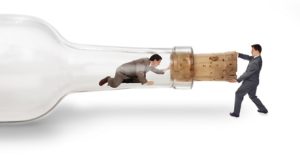
As a manager, you have a number of critical tasks that are general to your position as opposed to specific to your industry. These include ensuring the continued health of the organization, setting the moral compass for your stakeholders, providing for succession by training and documenting, leading the effort in compliance of regulations and safety needs, and … elimination of all possible bottlenecks that impede the efficiency of your organization.
What is the bottleneck?
The definition of a bottleneck in your business is one that constricts the flow of work from

one area to another in the flow of product or service through your organization.
The three common factors making a bottleneck
A bottleneck in your organization’s flow of product or service can happen, shift, or disappear quickly. Common to all bottlenecks are three factors:
- All product, labor, and cost before the bottleneck are impeded from creating maximum efficiency by being forced to slow output or build inventories. This is a costly loss for any business and one that should be a focus for your management as soon as identified.
- The bottleneck itself strains to keep up with demand, often to the point of reducing its own efficiency in the process of attempting to keep up with demand.
- All processes after the bottleneck are slowed for lack of flow into their zone of control and waste time, money, space and output, always resulting in reduced revenues and profits.
Of course, you could fit that definition
You can be the bottleneck. If people are waiting for you to respond to a question or make a decision about design, process, spending for a core need, or any of tens of critical decisions, you are creating a slowing or stoppage of work before you and idle resources behind you. If this describes you at any moment in your day, you should consider removing yourself from the bottleneck list by delegation, reduction of your non-critical workflow, or (heaven forbid) increasing your hours of production.
Remove that impediment!
 If failing to hire a critical employee is the cause of reduced efficiency, you must act quickly to either make an effective hire or alter the environment that creates the urgent need, all to remove that bottleneck.
If failing to hire a critical employee is the cause of reduced efficiency, you must act quickly to either make an effective hire or alter the environment that creates the urgent need, all to remove that bottleneck.
And if an inefficient or undersized machine or department or process is creating a backup of critical path work flow, you must address this as an urgent matter whose cost is much more than the cost of the machine or person needed, but the amplified cost of the lost output it affects.
One of your most important jobs
You, as a successful manager, must be attuned to and responsible for elimination of all forms of bottlenecks within your span of control. Watch for, and stamp out, all those you identify as soon as you find them. The effect of your action is magnified several-fold at the output stage of your business, leading to increased customer satisfaction and increased profits.












